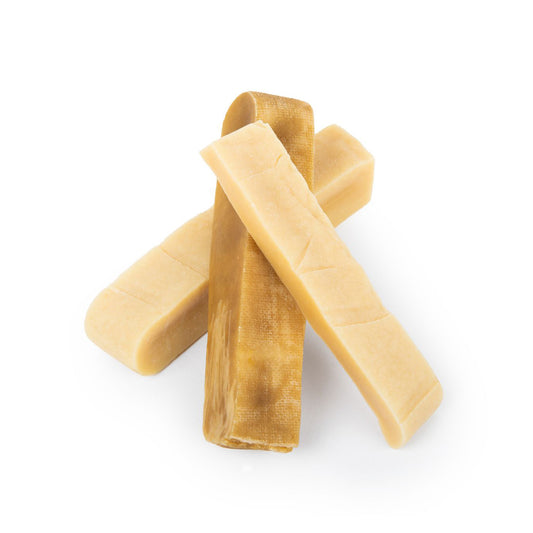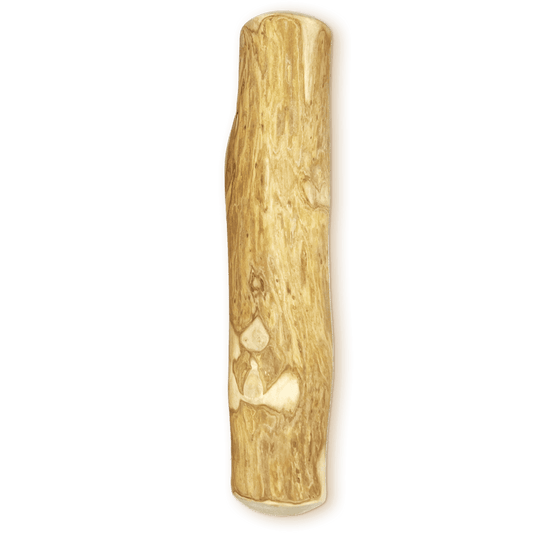If you're a dog owner, you may have observed your furry companion biting their feet and nails from time to time. While it might seem harmless, excessive foot and nail biting in dogs can indicate underlying issues that need attention. In this comprehensive blog article, we'll explore why dogs bite their feet and nails, including possible medical and behavioral causes, and offer practical solutions to help your canine friend find relief.

Section 1: Common Reasons Dogs Bite Their Feet and Nails
1.1. Allergies and Skin Irritations:
Allergies are a common cause of skin irritations and itching in dogs, which can lead to excessive foot and nail-biting. There are three primary types of allergies that can affect dogs:
Food Allergies: Dogs can develop allergies to specific ingredients in their food, such as proteins (chicken, beef, or fish), grains (wheat, corn, or soy), or additives. These allergies trigger an immune system response, leading to skin problems like itching, redness, and inflammation. Dogs often chew on their paws as a way to alleviate this discomfort. Identifying and eliminating the allergenic ingredients from your dog's diet can help manage food allergies.
Environmental Allergies (Atopy): Just like humans, dogs can be allergic to environmental factors like pollen, dust mites, mold, and certain grasses. These allergens can be inhaled or come into contact with the skin, leading to allergic reactions. The skin is one of the primary organs affected, resulting in itching, redness, and hot spots. Dogs may chew or bite their feet to soothe the itching caused by atopic dermatitis. Treatment often involves allergen avoidance, antihistamines, or immunotherapy (allergy shots) prescribed by a veterinarian.
Contact Allergies: Dogs can also develop skin irritations due to contact with irritants or allergens in their environment. This includes coming into contact with certain plants, cleaning products, or materials like rubber or plastic. The symptoms may manifest as localized itching and redness, often leading to chewing on the affected areas, including the paws. Identifying and eliminating the source of the contact allergy is crucial to providing relief.
Fleas and Parasites:
Fleas and other external parasites are notorious for causing intense itching and discomfort in dogs, often leading to excessive foot and nail-biting. Understanding the role of these pests in your dog's discomfort is crucial for effective management:
Fleas:
Fleas are one of the most common external parasites that can infest dogs. These tiny, blood-feeding insects can be found in your dog's fur, especially around the neck, tail, and abdomen. When fleas bite, they inject saliva that contains allergenic compounds, triggering an allergic reaction in some dogs. This reaction results in itching, redness, and inflammation, particularly on the lower back and base of the tail. In an attempt to alleviate the itching, dogs may chew their paws and nails. Preventing and treating fleas is vital. This involves regular flea prevention measures, such as topical treatments, oral medications, or flea collars, as recommended by your veterinarian.
Ticks:
Ticks are another external parasite that can cause skin irritations in dogs. These arachnids attach themselves to a dog's skin and feed on their blood. Tick bites can transmit various diseases, and the irritation from a tick bite may lead to localized itching and discomfort. While tick bites don't typically result in the same intense itching as fleas, dogs may still chew or nibble at the affected area. To prevent tick infestations, use tick preventatives, and regularly inspect your dog for ticks, especially after outdoor activities in tick-prone areas.
Mites:
Several types of mites can infest a dog's skin and ears, leading to itching, hair loss, and skin infections. Sarcoptic mange, for example, is caused by the Sarcoptes scabies mite and is highly contagious among dogs. Infected dogs often chew and scratch themselves intensely, including their paws, in an attempt to relieve the itching. Mite infestations require specific treatments prescribed by a veterinarian, which may include medicated shampoos, topical ointments, or oral medications.
Internal Parasites:
Some internal parasites, such as intestinal worms, can cause discomfort in dogs, but their symptoms are typically not related to foot or nail biting. However, it's essential to maintain a regular deworming schedule for your dog to prevent and manage internal parasites, as they can lead to a range of health issues.
1.3. Dry Skin and Winter Weather:
Dry, cold winter weather can take a toll on your dog's skin, often leading to flakiness, itching, and a strong urge to bite or chew their paws. Understanding how winter weather contributes to dry skin in dogs is essential for effective management:
Reduced Humidity: During the winter months, the air tends to be drier both indoors and outdoors. This decrease in humidity can result in the evaporation of moisture from your dog's skin, leading to dryness and flakiness. As the skin becomes dry and irritated, dogs may resort to biting their paws in an attempt to relieve the itchiness.
Exposure to Cold and Wind: Exposure to cold temperatures and brisk winter winds can further exacerbate dry skin in dogs. The skin's natural protective barrier can become compromised, making it more susceptible to dryness and irritation. Paws, in particular, are vulnerable as they come into direct contact with cold surfaces, and dogs may chew on them to generate warmth or alleviate discomfort.
Insufficient Grooming and Moisturization: Winter often means reduced outdoor activity and less self-grooming for dogs. Additionally, central heating in homes can further dry out the air, impacting the moisture content of your dog's skin. This combination of factors can contribute to the development of dry skin conditions.
1.4. Nail Issues:
Nail problems in dogs, such as overgrown, ingrown, or broken nails, can be a source of discomfort and lead to dogs biting or chewing on their nails. Understanding these issues and their potential causes is crucial for effective management:
Overgrown Nails: Dogs' nails naturally grow over time and require regular trimming to maintain an appropriate length. When left untrimmed, nails can become overgrown, affecting a dog's gait and causing discomfort when walking. Overgrown nails may also get caught on objects or furniture, leading to painful breaks or splits.
Ingrown Nails: Ingrown nails occur when a dog's nails curl inward and start growing into the surrounding flesh. This condition is not only painful but can also lead to infections if left untreated. Dogs may chew on or lick their paws in an attempt to alleviate the discomfort caused by ingrown nails.
Broken or Split Nails: Dogs can easily break or split their nails, especially during activities like running or playing. A broken nail can expose the sensitive quickly, causing pain and bleeding. Dogs often try to alleviate this discomfort by chewing or licking the affected nail.
1.5. Stress and Anxiety:
Stress and anxiety can manifest in dogs as compulsive behaviors, including foot and nail-biting. Understanding the role of stress and anxiety in your dog's behavior is essential for effective management:
Triggers for Stress and Anxiety: Dogs can experience stress and anxiety due to various factors, including changes in their environment, separation from their owners, loud noises (thunderstorms, fireworks), visits to the veterinarian, or encounters with other dogs. These stressors can lead to restlessness and heightened anxiety levels.
Compulsive Behaviors: Some dogs cope with stress and anxiety by engaging in repetitive and compulsive behaviors, such as excessive grooming, tail chasing, or, in this case, foot and nail-biting. These actions can provide temporary relief from their emotional distress but can become problematic if left unchecked.
Signs of Stress and Anxiety: It's essential to recognize the signs of stress and anxiety in dogs, which can include pacing, panting, drooling, trembling, avoidance behaviors, and changes in appetite. If your dog exhibits any of these signs along with foot and nail-biting, it may be indicative of underlying stress or anxiety issues.
Section 2: Diagnosing the Underlying Cause
2.1. Veterinary Examination:
A veterinary examination is a critical step in understanding and addressing the root causes of why your dog is biting their feet and nails. It involves a comprehensive evaluation by a trained veterinarian to identify any underlying medical issues or conditions contributing to this behavior. Here's a breakdown of what this examination entails:
Physical Examination:
A thorough physical examination is the first step. The veterinarian will inspect your dog's overall health, including their skin, coat, paws, and nails. They will look for signs of redness, swelling, lesions, or abnormalities on the paws and in other areas.
History and Symptoms:
Your veterinarian will gather a detailed medical history from you. This includes information about your dog's diet, exercise routine, recent changes in environment or lifestyle, and when you first noticed the foot and nail-biting behavior. Be sure to provide accurate and complete information to aid in diagnosis.
Allergy Testing:
If allergies are suspected as a potential cause, your veterinarian may recommend specific allergy testing. This can include skin tests or blood tests to identify allergens that may be triggering skin irritations and itching.
Skin Scraping and Cultures:
In cases where infections are suspected, your veterinarian may perform skin scrapings or take skin cultures to identify any bacterial or fungal infections that could be contributing to the discomfort.
2.2. Identifying Behavioral Issues:
Identifying and addressing behavioral issues as potential causes of your dog's foot and nail-biting behavior is an essential part of understanding and resolving this problem. Here's a detailed breakdown of how to identify and manage behavioral issues:
Consultation with a Veterinary Behaviorist or Dog Trainer:
If your dog's foot and nail-biting behavior is believed to have a behavioral component, it's advisable to consult with a qualified veterinary behaviorist or professional dog trainer. These experts specialize in understanding canine behavior and can conduct a comprehensive assessment of your dog's actions.
Thorough Behavior Evaluation:
The behaviorist or trainer will conduct a thorough evaluation of your dog's behavior. They will seek to understand not only the foot and nail-biting behavior but also any other related behaviors, triggers, and patterns. They may ask you detailed questions about when and where the behavior occurs, what precedes it, and what follows it.
Identifying Stressors and Triggers:
Understanding the stressors and triggers that lead to foot and nail biting is crucial. Common triggers may include separation anxiety, fear of loud noises, changes in routine or environment, or interactions with other dogs or pets. Identifying these triggers is essential for developing an effective behavior modification plan.
Observation and Analysis:
The behaviorist or trainer will observe your dog's body language and reactions in various situations to pinpoint signs of stress, anxiety, or compulsive behavior. They may also conduct specific behavioral tests to assess your dog's reactions.
Medical Evaluation:
It's essential to rule out any underlying medical issues before solely attributing the behavior to a behavioral problem. The behaviorist may recommend a thorough veterinary examination to ensure there are no medical causes contributing to the behavior.
Developing a Behavior Modification Plan:
Based on their evaluation, the behaviorist or trainer will develop a behavior modification plan tailored to your dog's specific needs. This plan may include techniques like desensitization, counter-conditioning, positive reinforcement training, and the use of calming tools or strategies.
Ongoing Support and Monitoring:
Behavioral issues often require ongoing support and monitoring. The behaviorist or trainer will guide you in implementing the behavior modification plan and provide you with tools and techniques to manage and reduce the foot and nail-biting behavior. Regular follow-up sessions may be necessary to track progress and make adjustments.
Section 3: Treating and Preventing Foot and Nail Biting
3.1. Medical Treatments:
Medical treatments are an essential aspect of addressing foot and nail-biting in dogs, particularly when there are underlying medical causes. Here's an in-depth exploration of the various medical treatments that may be recommended:
Allergy Medications:
If allergies are identified as the primary cause of your dog's foot and nail-biting, your veterinarian may prescribe allergy medications. These can include antihistamines to reduce itching and inflammation or corticosteroids for more severe cases. The goal is to alleviate the allergic response and provide relief from discomfort.
Antibiotics or Antifungals:
In cases where your dog has developed skin infections due to excessive licking and biting, your veterinarian may prescribe antibiotics for bacterial infections or antifungal medications for fungal infections. These medications target the underlying infection and aid in the healing process.
Flea and Parasite Control:
If fleas or other external parasites are contributing to the itching and discomfort, your veterinarian will recommend appropriate flea control measures. This may involve topical treatments, oral medications, or collars designed to eliminate and prevent flea infestations.
Anti-Itch Medications:
In some cases, your veterinarian may prescribe specific anti-itch medications, such as Apoquel or Cytopoint. These drugs target the receptors responsible for itching and can provide rapid relief for dogs suffering from allergies or skin irritations.
After initiating medical treatment, it's essential to schedule regular follow-up appointments with your veterinarian. These appointments allow your veterinarian to assess the progress of treatment, make any necessary adjustments, and ensure that your dog's condition is improving.
3.2. Topical Treatments:
Topical treatments are an integral part of managing foot and nail-biting in dogs, particularly when addressing skin irritations and itching. These treatments are applied directly to the affected areas and can provide relief and support skin health. Here's a comprehensive overview of topical treatments for dogs:
Medicated Shampoos:
Medicated shampoos are specially formulated to address various skin conditions, including itching and inflammation. Ingredients like oatmeal, aloe vera, hydrocortisone, or antifungal agents can soothe irritated skin and provide relief.
Creams and Ointments:
Topical creams and ointments can be applied directly to localized areas of skin irritation or hot spots. These products often contain ingredients like hydrocortisone to reduce itching and inflammation. Gently massage the cream or ointment into the affected area, following your veterinarian's recommendations.
Paw Balms and Moisturizers:
Paw balms and moisturizers are specifically designed to keep a dog's paw pads hydrated and prevent dryness and cracking. They can be particularly beneficial during dry winter months or in hot, arid climates. Apply the balm or moisturizer to your dog's paw pads and massage it gently.
Cooling Sprays:
Cooling sprays contain ingredients like aloe vera and menthol to provide a cooling sensation and relieve itching and discomfort. These sprays are useful for soothing hot spots or irritated skin. Follow the product instructions and avoid spraying near your dog's eyes, nose, or mouth.
Calming Sprays:
Calming sprays may contain pheromones or natural ingredients that promote relaxation and reduce stress-related itching. They can be sprayed on your dog's bedding or in their environment to create a soothing atmosphere.
Antiseptic Sprays:
In cases where skin irritation has led to minor wounds or sores, antiseptic sprays can help prevent infection. These sprays disinfect the affected area and promote healing. Ensure that your dog doesn't ingest the spray, as some may not be safe for ingestion.
Section 3.3: Dog Chews as a Beneficial Solution
In addition to the aforementioned treatments and preventive measures, dog chews can be a valuable tool in managing a dog's compulsion to bite its feet and nails.
Specialized dental chews and toys designed for dogs not only serve as a tasty distraction but can also help improve overall oral health. Chewing on these items can engage your dog's natural instinct to gnaw, providing mental and physical stimulation. Moreover, certain dog chews are fortified with ingredients like Omega-3 fatty acids and vitamins, which can promote skin and coat health. Always consult with your veterinarian to choose the right type of chew for your dog's specific needs, ensuring that it complements the overall treatment plan. These chews can be a tasty and effective way to redirect your dog's attention away from their paws while contributing to their overall well-being.
Hence!
At peaksnpaws, we take great pride in producing high-quality dog chews that are safe and enjoyable for your furry friend. Our chews are made from natural and renewable resources and are free from harmful chemicals and additives, making them a safe and healthy chew option for dogs of all sizes and ages.
We understand that safety is a top priority for pet parents, which is why we take extra care in ensuring that our chews are properly cleaned and sterilized before being packaged and shipped to you.
When choosing a dog chew for your dog, it's important to consider the quality of the product. Cheaper, low-quality chews may pose a hazard to your dog's health and safety, which is why we only use the highest-quality materials in our products. Our chews are designed to be long-lasting and durable, making them a great option for aggressive chewers and dogs who love to chew.
We also understand that every dog is unique, which is why we offer a range of sizes and textures to suit different breeds and chewing habits. Our chews are also free from common allergens such as wheat, corn, and soy, making them a great option for dogs with food sensitivities.
Conclusion:
Understanding why dogs bite their feet and nails is crucial for providing appropriate care and comfort to our four-legged friends. Whether it's allergies, parasites, or behavioral issues, addressing the root cause is essential. By consulting with a veterinarian, implementing preventive measures, and providing proper treatment, you can help your dog lead a happy and healthy life free from the discomfort of constant foot and nail-biting.











